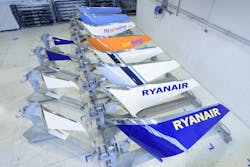Ried/10 November 2016 - The development and production of winglets has been a core competence of FACC for many years: The company recently reached an important milestone when it delivered the 7,500th winglet shipset to Aviation Partners. The landmark delivery is the latest highlight in the successful 15-year collaboration with the US company, and it underscores the technological expertise of FACC in the area of lightweight components for the civil aviation industry.
Winglets are the turned-up extensions at the tips of the wings. By reducing air resistance, they make the aircraft more aerodynamic, efficient and environmentally friendly. FACC delivered the first of these high-tech components to Aviation Partners, the Seattle-based inventor and marketer of the Blended Winglet, back in 2002. “The collaboration with Aviation Partners has proved very satisfying over the years,” said Robert Machtlinger, CEO of FACC. “Our expertise in the development and production of high-quality fiber-reinforced composite components and systems has enabled us to develop into a globally renowned winglet specialist. As a result, we have managed to improve the performance of the winglets continuously and save some 25 billion liters (6.6 billion gallons) of jet fuel with our innovations.”
From its factory in Ried im Innkreis, Upper Austria, FACC produces these fuel-saving winglets for its customer Aviation Partners. They are used on various types of aircraft, most notably the Boeing 737NG and 757 families, as well as on the business jets of Dassault Falcon and Beechcraft-Hawker. The winglets all have one thing in common: Depending on their model, they can cut fuel consumption by four to six percent and reduce harmful emissions, thereby making the aircraft more efficient.
Research on the winglets of the future
The fruitful collaboration with Aviation Partners has resulted in further improvements to the aerodynamics of the winglets in the recent past. One example is the winglet with ventral fin, which has a downwards-angled strut on its underside and reduces drag on the wings by a further two to three percent.
“We believe that innovative and more intelligent materials will play an important role in future technology in the area of aircraft manufacturing,” claims Machtlinger. “We also work closely with the national research promotion agency, FFG, and with international research bodies in this area.” In its research work in the Aerostructures department, FACC is focusing increasingly on so-called morphing structures, i.e. movable, sensor-controlled structures that adapt optimally to any flight position. The latest prototype featuring this technology is a winglet fitted with active control flaps that allow the shape of the wingtips to adjust to the current flight conditions in real time. “These winglets offer a range of other benefits – including even better aerodynamics, lower noise levels, and improved load distribution on the wing,” explains Machtlinger when emphasizing the effects of the innovative Morphing Winglets, which have already been tested successfully in the wind tunnel and are currently being evaluated by customers.
About FACC
FACC AG is one of the world’s leading companies in the design, development and production of advanced fiber reinforced composite components and systems for the aviation industry. Their range of products extends from structural components for the fuselage and wings to engine components and complete passenger cabins for commercial aircraft, business jets and helicopters. FACC is a supplier to all large aircraft manufacturers such as Airbus, Boeing, Bombardier, Embraer, Sukhoi, and COMAC, as well as for engine manufacturers and sub-suppliers of manufacturers. In the business year of 2015/16, FACC achieved a turnover of 587.5 million Euros and employed 3,062 people at the 29 February 2016 balance sheet date. Further information is available at www.facc.com.



